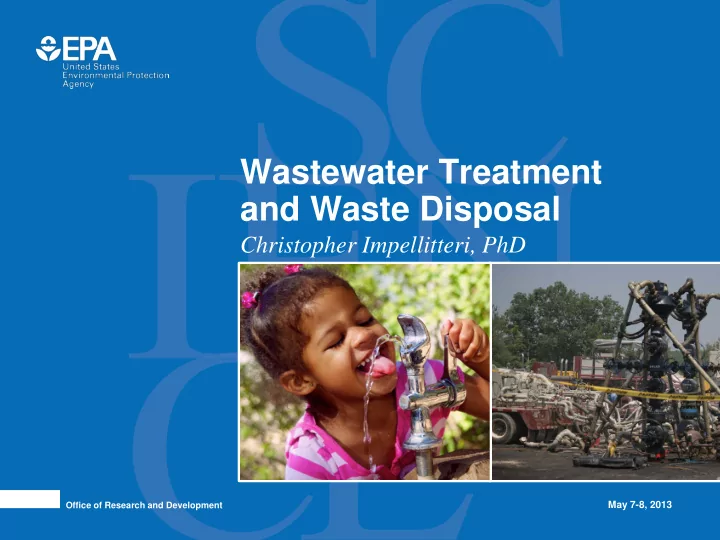

Wastewater Treatment and Waste Disposal Christopher Impellitteri, PhD May 7-8, 2013 Office of Research and Development
Wastewater Treatment and Waste Disposal What are the possible impacts of inadequate treatment of hydraulic fracturing wastewater on drinking water resources? 1
Charge Question #11 EPA is currently able to detect and quantify selected anions, cations and metals in hydraulic fracturing wastewater and is considering modifying analytical methods for detecting selected organics in wastewater. Please provide recommendations for other specific chemicals that are of interest from a wastewater treatment and/or drinking water treatment perspective . 2
Wastewater Composition • Chemicals used in the hydraulic fracturing fluid – Including breakdown and reaction products • Chemicals found in the fractured formation – Brine (total dissolved solids, chloride, bromide) – Trace elements (e.g., mercury, lead, arsenic) – Naturally occurring radioactive material (e.g., radium, thorium, uranium) – Gases (e.g., methane, hydrogen sulfide) – Organic material (e.g., polycyclic aromatic hydrocarbons, volatile organic compounds (VOCs), semi-volatile organic compounds (SVOCs)) 3
Wastewater Research Projects PROJECT DESCRIPTION Wastewater Assessment of the efficacy of common wastewater Treatability Studies treatment processes on removing selected chemicals found in hydraulic fracturing wastewater Br-DBP Precursor Assessment of the ability of chemicals found in hydraulic Studies fracturing wastewater to form brominated disinfection byproducts (Br-DBPs) during drinking water treatment processes Source Development of a method to identify the potential source(s) Apportionment of surface water contamination Studies Surface Water Modeling of concentrations of selected chemicals at public Modeling water supplies downstream from wastewater treatment facilities discharging treated hydraulic fracturing wastewater 4
Br-DBP Precursor Studies Wastewater Treatment Facility Treated Hydraulic Public Water Fracturing Wastewater Supply Intake Elevated concentrations of bromide GOALS • Analyze and characterize wastewater for presence of halides (bromide, chloride) • Evaluate effects of high TDS upon chlorination of surface water receiving discharges of treated wastewater 5
Wastewater Treatability Studies Identify Common Treatment Processes • Publicly-owned treatment works (POTWs) (e.g., biological processes) • Commercial treatment systems (e.g., chemical precipitation, evaporation) Identify Chemicals for Study • Anions, metals/inorganics, TDS, radionuclides • VOCs, SVOCs being considered Conduct Experiments Identify partitioning of selected chemicals during common treatment processes 6
Chemical / Physical Processes • Commercial treatment systems • Field studies • Treatment processes – Coagulation, flocculation, filtration, distillation • Sample collection – Influent, effluent, residuals • Analytes – Anions, metals/inorganics, TDS, radionuclides – VOCs, SVOCs under consideration 7
Biological Processes • POTWs • Bench studies with chemostat reactors – Blend hydraulic fracturing wastewater with synthetic municipal wastewater • Sample collection – Influent, effluent • Monitor effects on biological processes • Analytes – Anions, metals/inorganics, TDS – VOCs and SVOCs under consideration 8
Potential Analytes GROUP EXAMPLES • Benzene VOCs • Chloroform • Fluoranthene SVOCs • Napthalene • Phenol • Bromide Anions • Chloride • Sulfate • Arsenic Metals / Inorganics • Chromium • Radium Radionuclides • Thorium • Uranium Analytes must be measurable in high-TDS matrices 9
Charge Question #12 What key trends in wastewater management , if any, may affect the volume and/or composition of hydraulic fracturing wastewater being treated and discharged to surface water? 10
Wastewater Management Practices Options • Disposal through underground injection control wells • Treatment followed by: – Reuse for additional hydraulic fracturing activities – Direct discharge to surface water (under NPDES permit) – Indirect discharge to surface water (via POTW) – Underground injection of treated brine – Beneficial reuse • Evaporation ponds General Decision Criteria • Availability of treatment/disposal/reuse options • Treatment/disposal/reuse cost • Transportation cost • Local or regional water needs/availability 11
Wastewater Management Practices EPA will obtain a “snapshot” of hydraulic fracturing wastewater management practices PROJECT ANTICIPATED AVAILABLE INFORMATION Well File Review Volume and final disposition of flowback and produced water from wells hydraulically fractured in 2009-10 FracFocus Analysis Data on water types reported in FracFocus by volume and geographic location, focusing on recycled water, between January 2011 and February 2013 Literature review Current state of the science with respect to hydraulic fracturing wastewater management and reuse 12
Technical Stakeholder Input* • Potential local impacts and public opinion play a role in disposal of hydraulic fracturing wastewater • Saline water can be used in some hydraulic fracturing fluids, but this may negatively impact equipment • Recycling occurs when it is cost-effective • High TDS concentrations limit effectiveness of some treatment technologies • Produced water volumes may exceed the potential for reuse, leading to a future need for treatment and disposal • Concern about management of treatment residuals 13 *Technical Workshop 2011, Technical Roundtable 2012
Technical Stakeholder Input* • Industry is rapidly changing, with an increased emphasis on using recycled or brackish/salt water • Long-term vision involves sharing water • Improved monitoring and tracking of wastewater needed • Option for full scale watershed study, tiered with suite of chemicals identified 14 *Technical Workshop 2013
Charge Questions 11. EPA is currently able to detect and quantify selected anions, cations and metals in hydraulic fracturing wastewater and is considering modifying analytical methods for detecting selected organics in wastewater. Please provide recommendations for other specific chemicals that are of interest from a wastewater treatment and/or drinking water treatment perspective. 12. What key trends in wastewater management, if any, may affect the volume and/or composition of hydraulic fracturing wastewater being treated and discharged to surface water? 15
Recommend
More recommend